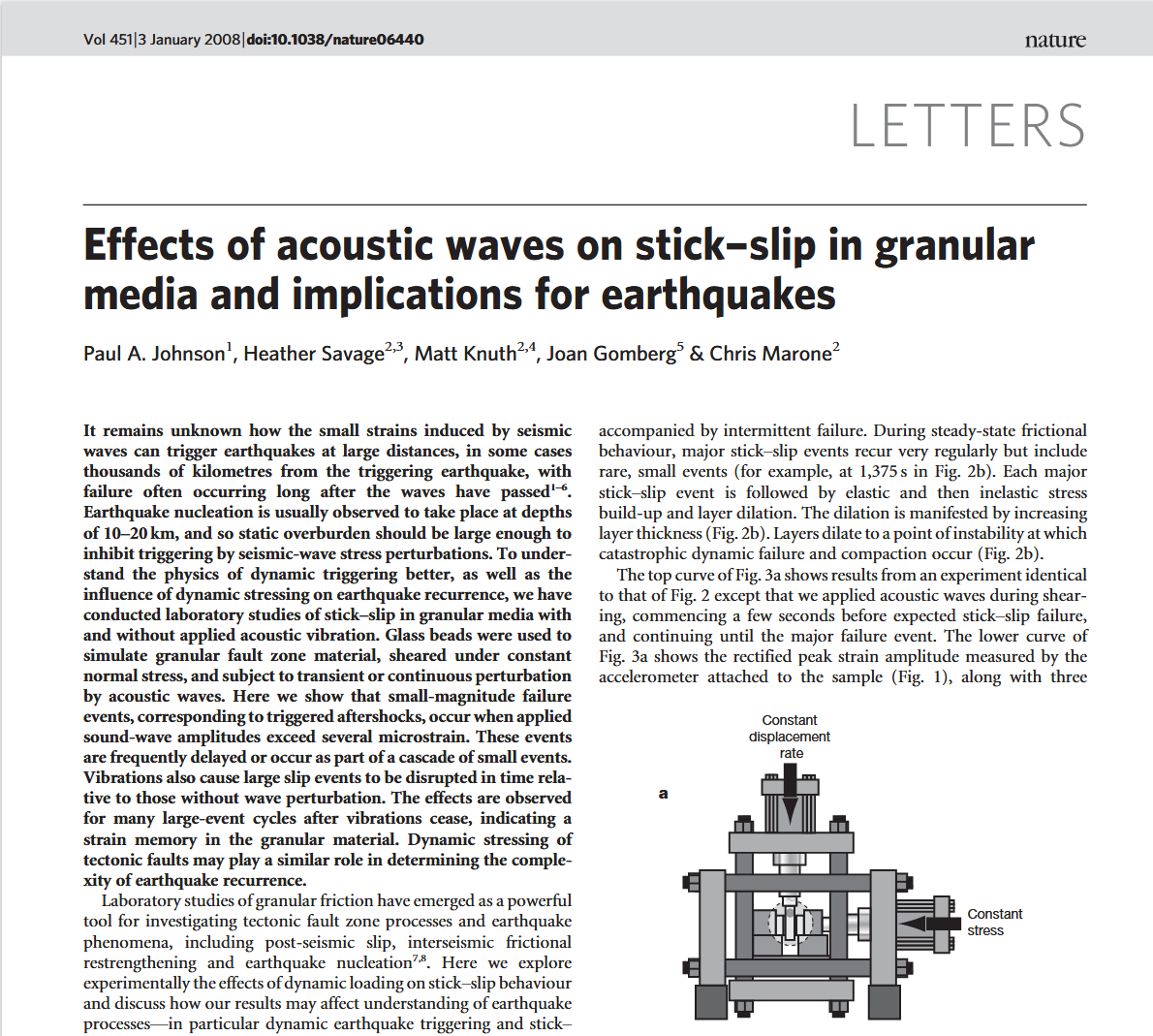Abstract
It remains unknown how the small strains induced by seismic waves can trigger earthquakes at large distances, in some cases thousands of kilometres from the triggering earthquake, with failure often occurring long after the waves have passed. Earthquake nucleation is usually observed to take place at depths of 10–20 km, and so static overburden should be large enough to inhibit triggering by seismic-wave stress perturbations. To understand the physics of dynamic triggering better, as well as the influence of dynamic stressing on earthquake recurrence, we have conducted laboratory studies of stick–slip in granular media with and without applied acoustic vibration.
地震波引起的微小应变如何能够在很远的地方触发地震,在某些情况下距离触发地震的地方有数千公里之遥,而破坏往往发生在地震波过去很久之后,这仍然是一个未知数。据观测,地震成核通常发生在 10-20 千米深处,因此静态覆盖层应足够大,以抑制地震波应力扰动引发地震。为了更好地理解动态触发的物理原理,以及动态应力对地震复发的影响,我们在实验室中进行了有声波振动和无声波振动的颗粒介质粘滑研究。
Glass beads were used to simulate granular fault zone material, sheared under constant normal stress, and subject to transient or continuous perturbation by acoustic waves. Here we show that small-magnitude failure events, corresponding to triggered aftershocks, occur when applied sound-wave amplitudes exceed several microstrain. These events are frequently delayed or occur as part of a cascade of small events. Vibrations also cause large slip events to be disrupted in time relative to those without wave perturbation. The effects are observed for many large-event cycles after vibrations cease, indicating a strain memory in the granular material. Dynamic stressing of tectonic faults may play a similar role in determining the complexity of earthquake recurrence.
玻璃珠被用来模拟颗粒状断层带材料,这些材料在恒定法向应力下受到剪切,并受到声波的瞬时或持续扰动。我们在此表明,当施加的声波振幅超过几个微应变时,就会发生与触发余震相对应的小震级破坏事件。这些事件经常被延迟或作为一系列小事件的一部分发生。相对于没有声波扰动的情况,振动也会导致大型滑移事件在时间上的中断。在振动停止后的许多大事件周期中都能观察到这种效应,这表明颗粒材料中存在应变记忆。构造断层的动态应力可能在决定地震复发的复杂性方面起着类似的作用。
Introduction
Laboratory studies of granular friction have emerged as a powerful tool for investigating tectonic fault zone processes and earthquake phenomena, including post-seismic slip, interseismic frictional restrengthening and earthquake nucleation. Here we explore experimentally the effects of dynamic loading on stick–slip behaviour and discuss how our results may affect understanding of earthquake processes—in particular dynamic earthquake triggering and stickslip recurrence. Dynamic earthquake triggering involves seismic waves from one earthquake promoting or inhibiting failure on the faults they disturb. Dynamic triggering has been clearly documented in a few cases far from an earthquake source, at distances much greater than the fault radius of the triggering source(outside the traditional ‘aftershock zone’), and increasing evidence suggests that it commonly occurs near the earthquake source.


